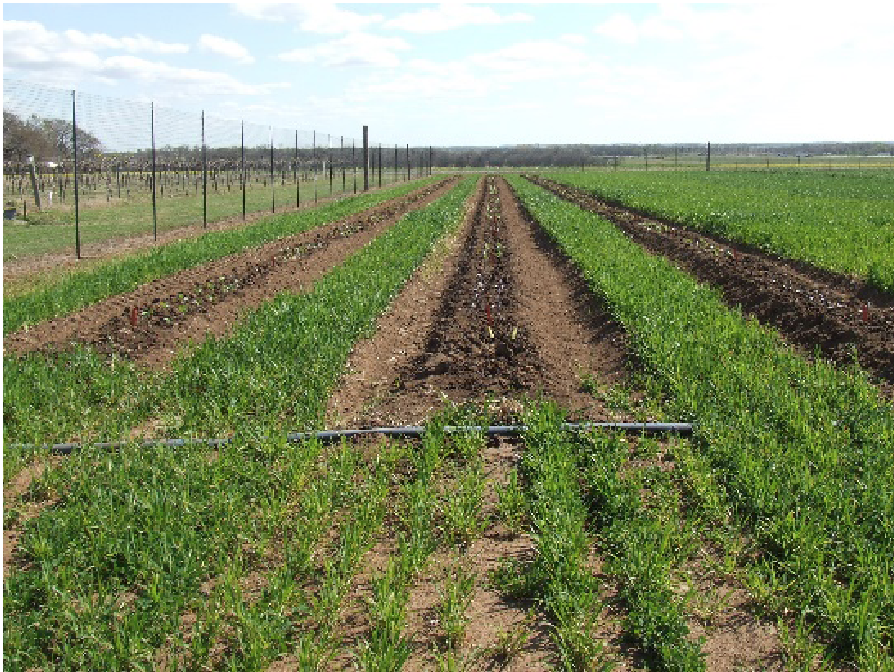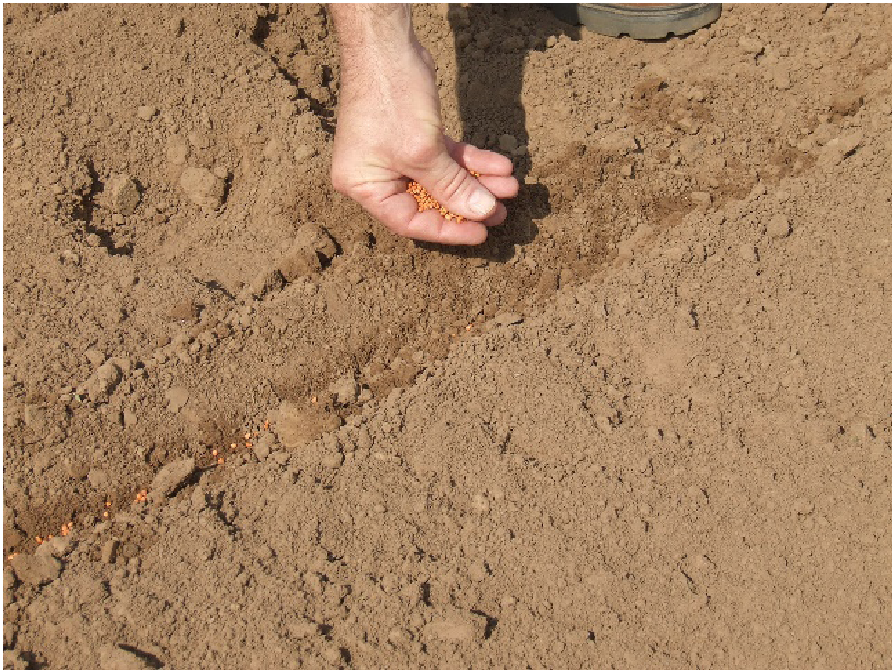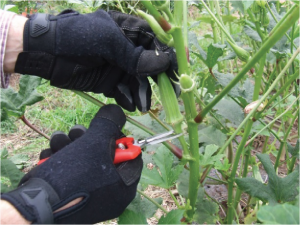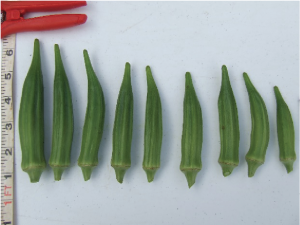Okra Production
Nutritional Content
Okra (Abelmoschus esculentus) is a member of the  mallow family and is considered a heat-tolerant vegetable crop that will flower and
fruit during high summer temperatures until first frost. Originating in Africa, it
is a traditional dish in the southern U.S. and produced for both fresh and processing
markets (Peirce, 1987 Wiley, New York). Okra has moderate levels of vitamins A and
C, thiamine, riboflavin and niacin and is also a source of calcium, phosphorus and
potassium (USDA Nutrient Database).
mallow family and is considered a heat-tolerant vegetable crop that will flower and
fruit during high summer temperatures until first frost. Originating in Africa, it
is a traditional dish in the southern U.S. and produced for both fresh and processing
markets (Peirce, 1987 Wiley, New York). Okra has moderate levels of vitamins A and
C, thiamine, riboflavin and niacin and is also a source of calcium, phosphorus and
potassium (USDA Nutrient Database).
Production Requirements
Okra performs best at temperatures between 75 to 95 F and, once established, will
flower and fruit throughout the summer months in Oklahoma. Okra belongs to a select
group of crops that will produce during extended periods of stressful conditions and
is a consistent producer even with hot and dry conditions. Expected yields for okra
vary, but can range between 10,000 to 12,000 pounds per acre under good growing conditions
in Oklahoma.
Sites and Soils
Okra is generally grown in locations where the crop will receive full sunlight throughout the day. Soil types for okra production can vary, with loams and sandy loams preferred, but even heavier soils can produce well if the soil drains well enough to prevent water-logging. If soil drainage is less than optimal, then okra will benefit from the use of free-standing raised soil beds. These beds can be formed by the use of implements such as a disk harrow adjusted to pull soil to the center or, if available, a commercial bed-shaper. The latter is the best option if drip irrigation and plastic mulch are to be utilized. Combination bed-shapers and mulch layers are used to form a bed and install drip tube and mulch in a single operation. If the producer does not want the expense of plastic mulch, then the bed-shaper can be used without installing mulch. As with most vegetable crops, okra will produce higher yields if supplemental irrigation is available during drought conditions. Root knot nematodes can be a problem and producers should rotate okra fields to non-host crop species, such as annual grasses or cereal grains, to reduce the chances of nematode populations increasing.
Free-standing raised bed.
Soil pH and Fertilizer
Okra is tolerant of a wide range of soil pH, but prefers soil with a pH between 6.0 and 6.8. If the soil pH is below 5.8, it should be limed to increase the pH to 6.0 or more. Soils at or below 5.8 can result in okra with poorly developed pods. Based on OSU soil test results, the following amounts of P2O5 and K2O are recommended (Table 1).
Table 1. Phosphorous and potassium requirements for okra.
| Phosphorous Requirements (pounds P2O5 per acre) | |||||
|---|---|---|---|---|---|
| When test shows | 0 | 10 | 20 | 40 | >65 |
| Add lbs. P2O5 | 150 | 125 | 100 | 55 | 0 |
| Potassium Requirements (pounds K2O per acre) | |||||
| When test shows | 0 | 75 | 125 | 200 | >250 |
| Add lbs. K2O | 150 | 125 | 100 | 50 | 0 |
Nitrogen – The nitrate-N value given by the soil test report should be used to determine nitrogen fertilizer needs on a particular soil. Subtract the available nitrogen given in the soil test results from that needed initially by the crop, for example: If the soil test indicates 15 pounds of available nitrogen subtract that 15 pounds from the pre-plant nitrogen application of 40 pounds, meaning 25 pounds of nitrogen would need to be applied prior to planting. On soils with low levels (5 pounds or less) of nitrogen, apply 40 pounds per acre of nitrogen preplant incorporated along with recommended phosphorus (P2O5 ) and potassium (K2O) (Table 1) prior to planting. High levels of nitrogen in the soil will cause excessive growth, delayed flowering and fruit set, therefore do not over-apply nitrogen. That said, okra will respond to nitrogen fertilizer, so top-dressing (applying fertilizer to the soil surface) with nitrogen fertilizer is advised. Two top-dresses of nitrogen–at 20 pounds per acre for each top-dress–with the first at three weeks after seedling emergence, then three weeks later should supply ample nitrogen for the crop. Another method of managing nitrogen is to inject it through a drip irrigation system used for crop watering. The advantage of applying nitrogen through the drip system is that smaller amounts of nitrogen can be applied on a more regular basis, thereby reducing the risk of over-applying nitrogen and reducing nitrogen loss from leaching by heavy rains. In addition, less nitrogen will be available for weed competitors, since nitrogen is applied down the row and not broadcast over a wider area. Even if fertilizer is injected through the drip irrigation system, it is wise to make a preplant application of nitrogen, phosphorus and potassium based upon soil test recommendations. The Southeastern U.S. Vegetable Crop Handbook has more details regarding fertilization through drip irrigation systems (https://www.growingproduce.com/southeasternvegetablecrophandbook/ ).
Soil Preparation
Conventional clean tillage methods can be used for soil preparation including deep-plowing,
disking and harrowing. An alternative to tilling the entire field area would be to
strip-till where a cool-season cover crop strip is left between every two to four
rows of okra, allowing for wind-breaks and spray alleys, if spraying is necessary
as well as for harvest.
One potential challenge with conventional clean tillage is the loss of soil organic
matter due to the physical cutting-up of organic residues and the increase of soil
microbial activity in breaking down organic residues. One solution to this loss of
organic matter would be the use of winter cover crops to increase soil organic matter.
When a winter legume, such as Austrian winter pea or winter clovers, etc. are included
with a cereal grass in the cover crop mix, not only will soil organic matter be increased,
but there will also be a gain in available nitrogen for subsequent warm-season crops,
such as okra. In southeastern areas of the state, an effective approach to okra production
is to plant the crop immediately after turning under cover crops of crimson clover
or smooth vetch, which can provide much of the crop nitrogen needs.
Conventional tillage.
Strip-tillage.
Planting
A key aspect of establishing okra is waiting until the soil temperature at planting
depth is at least 70 F, otherwise it may be difficult to obtain a uniform plant stand
from seed. However, if planted too late in the spring, flowering of some varieties
may be delayed due to okras’ day-length requirements for flowering. Transplants of
okra can also be used for establishment and will take approximately four weeks to
produce prior to transplanting in the field (HLA-6020). Transplanting into black-plastic mulch covered raised beds will reduce the time
to harvest, particularly during cool wet springs.
Direct seeding is the primary method used for crop establishment. Seed okra approximately
¾ to 1 inch in depth in rows 42 inches apart for dwarf types and 48 to 60 inches apart
for medium to large types. Harvesting can be difficult if rows are spaced too closely.
Seed should be spaced 3 to 4 inches apart in the row then thinned to 12 to 15 inches
apart for dwarf types and 18 to 24 inches apart for standard to large types. Okra
varieties shown in Table 2 include several medium to large types and one dwarf type.
The most recent OSU variety recommendations can be found in HLA-6035 Commercial Vegetable Varieties for Oklahoma. In addition to these recommended varieties, some larger-diameter and long-podded
types can be productive. Prior to purchasing seed, the grower should consider which
varieties are acceptable for the intended market.
Direct seeding.
Table 2. Okra varieties.
| Variety | Type |
|---|---|
| Annie Oakley II | Dwarf |
| Cajun Delight | Standard |
| Clemson Spineless | Standard |
| Emerald | Standard |
Weed Management
Whether conventional clean-tillage, strip-tillage or mulches are to be used, plans should be made to keep weeds controlled in okra to prevent competition and interference with pest management and harvest procedures. Weed control is critical in the early growth stages, while seedlings or transplants are small. Cultivation by tractor drawn cultivators, hand-hoeing or rototilling will be required in the early stages of crop development. The need for cultivation may be less after the crop begins to shade the soil surface. Crop height may prohibit using cultivation as the season progresses. When cultivating, be certain to cultivate at a depth that is shallow, but deep enough to be effective for weed control. Deep cultivation will damage crop roots and bring more weed seed to the surface. Further control of weedy species can be attained through the use of organic mulches once soil temperature has increased and crop growth is rapid. Some organic mulching materials during decomposition can compete directly with the crop for nitrogen, therefore don’t use mulches with high carbon-to-nitrogen ratios (bark, wood-chips and ground-wood products). There are a few paper mulch materials available on the market and these will help considerably in controlling weeds with the added benefit of not needing disposal at the end of the season. In addition, if the use of preemergence or postemergence herbicides is a viable option for the farm, they can reduce the need for tillage considerably. Labeled herbicides for okra can be found in E-832 Extension Agents’ Handbook of Insect, Plant Disease, and Weed Control, which can be found at the local county Extension office. As with any pesticide, be certain to read and follow label instructions pertaining to utilization on particular crops and how to safely store and use the material.
Organic mulch.
Irrigation
As with most vegetable crops, okra will produce its greatest yields if supplemental
irrigation is used to maintain soil moisture at optimum levels. Although okra can
tolerate both heat and drought, it will not maximize its potential for yield and profitability
if stressed by drought. Irrigation also may be needed to germinate seeds and for early
plant establishment if rainfall is not adequate to meet the plant needs. Okra flowers
and fruits during the hottest months of the summer and if adequate rainfall is not
occurring, the addition of 1.5 inches of water every 10 days during the production
season will provide for crop water needs.
Water can be delivered to the crop in a number of ways including overhead sprinklers,
furrow irrigation and drip systems. Drip irrigation is often used in situations where
there is not adequate water volume or pressure to meet the higher use requirements
for overhead systems. Drip systems are a very efficient means of distributing irrigation
water since water is either applied to the surface of the soil or subsurface with
buried drip-tape. Drip irrigation is the best option if the crop is grown on mulched
beds. Other benefits to drip irrigation include being able to carry on other field
operations during irrigation, not wetting the crop foliage, thereby reducing crop
disease pressure and being able to fertilize through the drip system.
Drip irrigation system with header line.
Insects
Various insect species may be found on flowering okra plants, but not all cause crop
injury. Aphids and mites can become a problem on okra, but frequent inspection can
alert growers to a build-up of these insect pests. If pods are harvested on schedule,
corn earworm should not be a problem because frequent picking will remove the eggs
from the field. Stink bugs and leaf footed bugs can damage pods by causing them to
have a bumpy, rather than smooth, appearance and can cause the pods to become crooked
instead of straight, rendering them unsalable in some markets. Insect problems may
be reduced by keeping the crop free of weeds that may harbor insect pests.
Diseases
Okra is susceptible to several plant diseases caused by fungi and nematodes. However,
only a few of these diseases are important in Oklahoma. Damping-off and seedling diseases
caused by the fungi Fusarium, Pythium and Rhizoctonia can result in poor stand establishment.
Seed should have a fungicide seed treatment and be planted into warm soil, which favors
rapid seed germination and plant growth. The southern root-knot nematode produces
galls on the root system, which reduce plant growth and vigor. Fusarium and Verticillium wilts
are periodic problems caused by the same fungi that attack cotton. There are no varieties
of Okra resistant to nematode and wilt diseases and they are best prevented by practicing
long-duration crop rotation with non-hosts crops. Blossom blight caused by the fungus Choanephora can
be a problem during hot and wet weather. A whitish-grey, fluffy growth causes decay
of flowers and young pods. Other foliar diseases caused by the fungi Alternaria and Cercospora can
cause leaf spots. Fungicides are registered for foliar diseases on okra should they
become severe, but these diseases usually are not damaging. Using cultural practices
that reduce wetness periods in the plant canopy such as drip irrigation and increasing
within row plant spacing may help reduce foliar diseases. For specific disease and
insect control measures, see the latest edition of the E-832 Extension Agents’ Handbook
of Insect, Plant Disease, and Weed Control.
Harvest and Handling
Okra plantings should be inspected on a regular basis and harvested when fruit are at the recommended size for the market. Fresh market okra is generally harvested when the pods are 3 to 4 inches in length, although some long-podded varieties will remain tender at greater lengths. Fruit is normally ready for harvest four to six days following bloom. The time needed will depend upon temperature and the amount of sunlight available. Processing okra is normally harvested at a larger size, depending upon pod toughness or according to the specifications of the contracted processor. Pods can be snapped by hand, but less damage to the pod stem will result by cutting the pods from the plant with a sharp knife or shears. Workers usually wear gloves, a long-sleeve shirt and long pants to avoid skin irritation caused by the short spines (trichomes) on the fruit.
As with most vegetable crops, harvesting in the morning will reduce the amount of
field heat in the fruit and will help to prolong the quality of the harvested okra.
During harvest, remove any over-mature pods from the plant to maintain production.
Plants with over-mature pods will reduce the amount of flowering and fruiting if the
pods are left on the plant. Okra plantings should be inspected on a regular interval
and harvested when fruit are at the recommended size for the market. Normally, okra
will need to be harvested about three times a week. Depending on the weather and the
amount of flowering, harvesting may be needed every two days to maintain uniform pod
size. Handle okra carefully to prevent bruising both during harvest and packing operations.
Food Safety
Although okra is rarely eaten raw , therefore not covered by the Food  Safety Modernization Act, it is still important for okra producers and handlers to
follow good agricultural practices and good handling practices. Following practices
for worker health and hygiene, cleaning and sanitizing harvesting equipment, etc.
will reduce the risk of food safety problems. Post-harvest care of the crop will also
help reduce crop loss due to fruit rots, mechanical damage and physiological injury.
It also will provide customers with peace-of-mind, by knowing the farmer is doing
their part to help protect the customer from food-borne pathogens.
Safety Modernization Act, it is still important for okra producers and handlers to
follow good agricultural practices and good handling practices. Following practices
for worker health and hygiene, cleaning and sanitizing harvesting equipment, etc.
will reduce the risk of food safety problems. Post-harvest care of the crop will also
help reduce crop loss due to fruit rots, mechanical damage and physiological injury.
It also will provide customers with peace-of-mind, by knowing the farmer is doing
their part to help protect the customer from food-borne pathogens.
Storage
Proper post-harvest handling is critical for keeping fruit in good condition 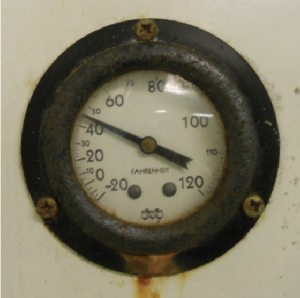 for sales. Okra is normally stored only briefly for both fresh and processing markets.
Okra pods have a very high respiration rate in warm temperatures and will heat up
if held in bulk at ambient temps. If the fruit is in good condition, hasn’t heated-up
or dried out from sitting at air temperature, it can often be stored for up to seven
to 10 days if maintained at 45 to 50 F and 90 percent relative humidity. Holding okra
at temperatures less than 45 F may cause chilling injury with surface discoloration,
pitting and decay. Fruit can also become discolored if held in large containers without
proper refrigeration.
for sales. Okra is normally stored only briefly for both fresh and processing markets.
Okra pods have a very high respiration rate in warm temperatures and will heat up
if held in bulk at ambient temps. If the fruit is in good condition, hasn’t heated-up
or dried out from sitting at air temperature, it can often be stored for up to seven
to 10 days if maintained at 45 to 50 F and 90 percent relative humidity. Holding okra
at temperatures less than 45 F may cause chilling injury with surface discoloration,
pitting and decay. Fruit can also become discolored if held in large containers without
proper refrigeration.
Packing and Marketing
First and foremost, during the planning process, be certain to consider and plan where
the crop will be marketed. Growing and selling perishable fresh produce like 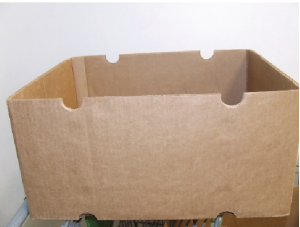 okra is nothing like storing and selling commodity type crops (grains, hay, etc.).
Before ordering seed and planting, producers should have a definite plan for where
and how they will harvest and market the crop. Pack okra according to what the market
demands. Tight packing or using large bulk containers will cause okra fruit to heat
rapidly and will also increase the amount of bruising to the fruit. Twenty-pound crates
or ½-bushel cartons are commonly used. Precool with cold air to remove field heat,
but do not hydrocool. Ship with refrigeration if at all possible, but don’t use top-ice
or any ice that will come in direct contact with the okra fruit, as this will cause
water spotting on the fruit.
okra is nothing like storing and selling commodity type crops (grains, hay, etc.).
Before ordering seed and planting, producers should have a definite plan for where
and how they will harvest and market the crop. Pack okra according to what the market
demands. Tight packing or using large bulk containers will cause okra fruit to heat
rapidly and will also increase the amount of bruising to the fruit. Twenty-pound crates
or ½-bushel cartons are commonly used. Precool with cold air to remove field heat,
but do not hydrocool. Ship with refrigeration if at all possible, but don’t use top-ice
or any ice that will come in direct contact with the okra fruit, as this will cause
water spotting on the fruit.



